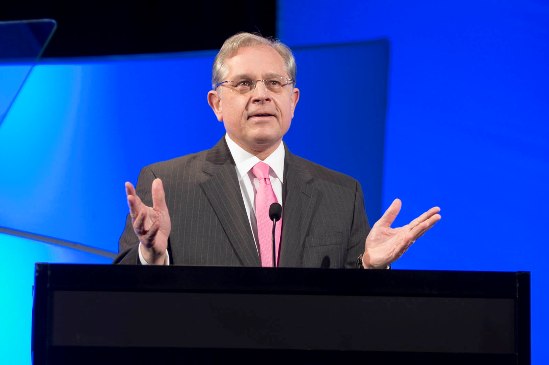Unifying the physician community and speaking with one voice will ensure the AMA’s “True North”—the physician-patient relationship—remains strong in the face of a semi-chaotic, rapidly changing health care environment, AMA Executive Vice President and CEO James L. Madara, MD, said in his address Saturday at the 2014 AMA Annual Meeting.
This relationship is the focal point of the AMA’s strategic plan, now in its second year. Dr. Madara gave delegates an update on a key portion of the strategic plan, which will guide physicians in speaking with a strong, unified voice.
“The vital work done here and across the AMA has had a common and indisputable feature: enabling, enhancing and protecting this sacred physician-patient relationship,” he said. “As physicians, we’ve been privileged to touch our patients’ lives in profound and lasting ways. We earn their trust. We earn their respect … They want us to lead the way toward a better health care future.”
To blaze this trail, it’s crucial to understand the needs of today’s physicians, which the AMA is investigating as part of its Professional Satisfaction and Practice Sustainability initiative. Identifying these needs will give the AMA insight into developing resources physicians can use to improve their professional satisfaction and spend more time on nurturing the physician-patient relationship.
In its work, the AMA already has identified common drivers of physician satisfaction and dissatisfaction with a study developed in collaboration with the RAND Corporation.
The AMA again is working with RAND to develop another study that will examine physician adoption of emerging payment models, allowing the AMA to understand challenges with these models and develop solutions.
This fall, the AMA will pilot resources to address systematic prescription renewal, pre-visit planning and collaborative documentation. The association also is working with vendors and regulators to make electronic health records (EHR) more user-friendly and better aligned with physician practice needs, Dr. Madara said.
Dedicating resources to investigating and improving physicians’ professional satisfaction is just one way for physicians to be successful in strengthening the physician-patient relationship—it’s also crucial to work together in presenting a united front. That’s not to say diversity of opinion isn’t necessary. In fact, it’s welcomed.
“The debates that characterize this House [of Delegates] lead to better and more informed policies,” Dr. Madara said. “Once consensus is achieved, it’s critical, if we want to take advantage of the natural power we have, that we take that next step—a much harder step—of supporting these policies with a single, unified voice.”
Dr. Madara also gave delegates an update on the AMA’s Improving Health Outcomes initiative. Collaborations with the YMCA of the USA to refer patients in three locations to the YMCA’s evidence-based Diabetes Prevention Program continue to move forward. On the hypertension front, physicians and care teams at 10 clinic sites in Illinois and Maryland are developing and testing a framework for achieving optimal hypertension control.
He also touched on the AMA’s Accelerating Change in Medical Education initiative, in which the 11 schools that received grants from the AMA are working to implement innovative curricula to better prepare the next generation of physicians. The medical schools are focusing on key areas that will become cornerstones in the future health care delivery system, including chronic health management, population health, team-based care and health information technology.
“I’m confident that we can further bolster the power of our collective voice,” Dr. Madara said. “Working together, we are advancing a strategic plan that invites and inspires.”
View a video of Dr. Madara's speech to the House of Delegates.




